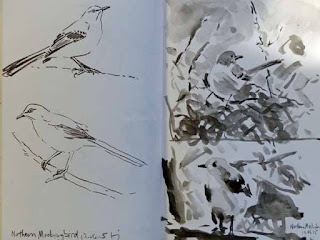 |
| Northern Mockingbird. Brush Pen and Sumi Sketches by Ken Januski. |
...Several times we have had occasion to allude to the careful and spontaneous styles. Let us now turn to this important matter.
The opposition between these two styles is a reflection of the opposition on a deeper level between two extreme attitudes possible for an artist: academic realism and free expression of mood. Technically speaking, the two styles are made possible by the extraordinary versatility of the Chinese brush, which can range from a quill-like hairline to the broad slashing of flying white or splashed ink -- all executed with the same brush. In Chinese the careful style is called kung pi, meaning roughly 'industrious brush' or 'laboring brush.' The spontaneous style is hsieh yi, literally 'writing ideas.'
Fritz van Briesen, The Way of the Brush: Painting Techniques of China and Japan,p.179-180, published by Tuttle Publishing.
The above quote isn't immediately relevant to the sketches pictured above, mainly because I'm a rank beginner at brush painting, with actual sumi brush or with the much more modern brush pen. But reading this excellent book has crystalized to some extent my thoughts on brush painting and on my goals in a more western type of painting, especially in regards to nature and wildlife. After reading this passage this morning I deliberately painted the sketches on right above with just a sumi brush with the purpose of illustrating my own, very amateurish 'spontaneous' style.
As will probably be obvious to anyone who's read much of this blog I lean much more in the direction of the spontaneous style. And most wildlife art, especially that shown in the US leans, quite heavily toward the academic style.
I studied Chinese brush painting for one semester a few centuries ago in San Francisco. Its appeal has always stayed with me though I haven't pursued it. My recent foray into brush pen sketches was precipitated by a desire to vary my lines in the prints I create, much as the sumi brush can and does. That started about six months ago I'd guess. But once I started I got seduced first by the brush pen, and just this week, by an actual sumi brush, though one too large for the paper I'm working on.
Eventually I do hope that exploring the richness of line in brush painting of China and Japan will lead me to richer and more varied lines in my prints. For now I'm happy to keep experimenting with both brush pen and sumi brush.
No comments:
Post a Comment